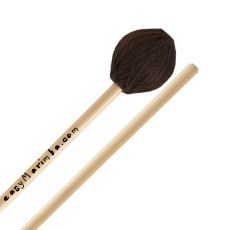Why a Marimba?
Key Factors:Colors - The untrained ear has never heard a major scale, and even if it did, it wouldn't even be able to distinguish its uniqueness from others. Each note on the marimba has it's own color. By associating colors to notes, kids can visually see that there are only 7 notes on the major scale before it starts repeating again. The repeating colors also infer that you can play the song starting on different octaves, because as long as you start on the same color, it will work.
Versatility - The marimba is a very versatile instrument. Depending on skill level, it can be played with just one mallot, two mallots, three or four mallots by a single person (professionals use two mallots in each hand). This also makes it possible for more than one person to play at the same time.
Engaging - Playing the marimba is actively very engaging. Kids have a lot of energy and they need to use it. Marimba is one of the few instruments that requires the most movement of the hands and arms. This helps kids control their short attention span because they are already focusing attention to getting the appropriate muscles moving while at the same time, improving their hand-to-eye coordination.
Sound - The resonator pipes give off a very rich and unique sound, this helps lengthen the attention span as kids are still discovering new sounds and it will not be boring to their ear.
Durability - The marimba is made of wood, this wood is hit by mallots. There are no small metal parts that turn or press. There are no strings to go out of tune or break. The marimba will almost always stay in tune, unless there is an extremely significant change in temperature or humidity that causes the wood to warp. Even so, it would still remain in tune with itself, because every note would warp in a similar fashion.
Size - Kids like big things. The bigger, the better. Why? Because they live in a big world, and big colorful objects are interpreted in the exact same way as an adult would see a caricature drawing. Ridiculous, funny, eggagerated, entertaining. Similar to why they want to ride that 25cent fire truck ride at the shopping centre. It is a mediator between ideologies of what something is supposed to be versus what it actually is in real life.
why the system works
Motivation - The main priority was to spark and instil interest in kids that have never played an instrument before and have not developed that portion of their brains yet.Reference - The sheet music specifically designed for the marimba can be read using colors or letters. This is because not all kids think with the same portion of their brains, some are more mathematical and will more readily associate letters with the note names. Others are more comfortable associating colors to sound. Of course, as they get older, both parts will develop, but there should be no reason why they should be limited by by this in their youth. By associating colors and letters to each note, the easy-marimba system lets kids choose to learn based on which way their brain thinks, classifies, and recalls.
Self-Teaching - Since the keys on the marimba are labelled, and colored, they can easily be referenced from the sheet music, in which the notes have the same color and letter. It is basically a matching game for the child. Since kids are able to match colors and letters, they will be able to learn to read music all on their own.
Familiarity - The sheet music was carefully chosen from popular songs that kids know, or have heard in kindergarten. Examples include Twinkle Little star, If you're happy and you know it, B.I.N.G.O, Old MacDonald, Wheels on the bus, Incy Wincy Spider, Jingle Bells, Frosty The Snowman, We Wish you a Merry Christmas and more.
Teamwork - The sheet music is written for one or two players. One player will play the melody, and the other add harmony with the bass notes. Both are equally important to developing a fundamental understanding of music.
